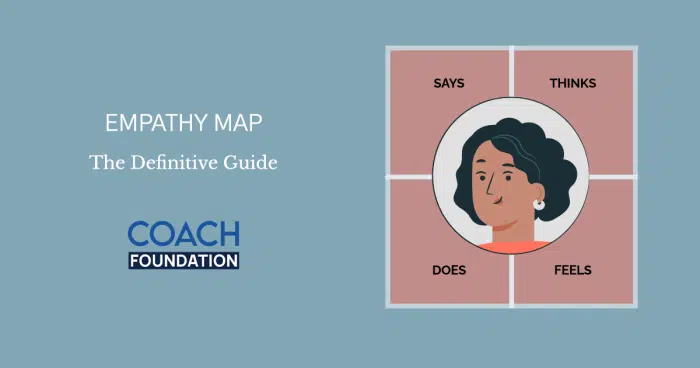Blog » Coaching Models and Techniques » Empathy Map
Empathy Map
The notion or the idea of an empathy map comes from design thinking. Design thinking, in short, is the notion of building businesses in a non-linear, iterative way that teams use to understand users, challenge assumptions, redefine problems and create innovative solutions to prototype and test the said idea. The very center of design thinking is empathy mapping.
In this article, we will delve deeper into fully understanding empathy mapping, its process, and how we can use it for coaching.
Let’s get to it then!
What is an empathy map?
Empathy maps are a useful tool that designers use to not only comprehend user behavior but also to visually convey their results to colleagues, bringing the team together around a common knowledge of the user. The empathy map was initially developed by Dave Gray at Xplane in an effort to reduce misunderstandings and miscommunications concerning target audiences, including clients and users.
You may discover a lot about your clients when you undertake user research, both from what they say and do and from more subtle cues like body language and facial expressions. All of these conclusions are visualized by an empathy map, which also provides the information you learn about your users during the research process in a concise, understandable manner.
To get a comprehensive understanding of the client, a coach should be able to make an empathy map on paper or a whiteboard in less than 20 minutes. Moreover, empathy mapping might highlight areas in client research where more information about the client’s wants has to be uncovered.
Empathy Map Format
An empathy map is essentially a rectangle with four quadrants, with the user or customer at the center. A category is included in each of the four quadrants to assist us better understand the client’s perspective. The four empathy map quadrants examine the client’s actions, thoughts, and feelings.
An empathy map organizes all of your client research into an understandable picture with the user in the center and the categories in each of the four outer quadrants.
Let’s examine the four quadrants in more detail and how they can capture a precise image of the user.
SAYS
Direct quotes from the user that have been gleaned from the research stage or prior data are included in this section. Statements like “I need something fast” or “I’m not sure where to proceed from here” can be present.
THINKS
Even though the information in this quadrant may be comparable to that in the “Says” area, it is primarily concerned with what a user is thinking rather than what they choose to say aloud. Use your qualitative research to find out what the user cares about and is thinking about.
Even more information about the consumer and their relationship to the given product or experience can be learned by examining why they might be reluctant to express their opinions aloud. As an illustration, say, “This is boring,” or “Am I doing this right?”
FEELS
What is the consumer feeling when using this product? and other similar inquiries are addressed in this area. likewise, “What concerns or excites the user?” List the emotions being produced, followed by a succinct explanation of what is causing the user to feel these ways, is a simple method to arrange this information. For instance, “Overwhelmed—too many choices to make” or “Anxious—wants to avoid wasting time.”
DOES
This quadrant depicts the user’s actions and their methods. To put it another way, how and what actions does the user take?
Example: Constantly looks for excuses. Lists the advantages and disadvantages of this action.
It is not uncommon for there to be similar remarks in each of the categories. Don’t censor the information to make it clearly match each area. Instead, reveal the user’s complexity by using the overlapping information. As fresh information becomes available, feel free to update your empathy map. But keep in mind that a sparsely covered map suggests a need for more user research.
The user’s goals section at the bottom of the map is an alternative method of empathy mapping. Here, the designer has captured the goals that the user has for the product both before it is created and after it is in use.
When to Use an Empathy Map
Anytime you feel the need to fully immerse yourself in a client’s environment, empathy maps can be used. For instance, they may be useful when
- filling out the client backstory by delving into the client’s behavior and past experiences,
- elaborating on client personas,
and capturing behaviors when interviewing clients during sessions
Fjord used empathy maps to comprehend the user journeys of the thousands of asylum seekers seeking refuge in reception centers throughout Finland in order to design and prototype better services for them to get an idea of the impact you can make with a straightforward tool like the empathy map. You can take this case study to implement empathy mapping in your sessions.
How to Create an Empathy Map
Understanding Customers – An Introduction to Customer Empathy Mapping
Empathy extends beyond one’s own character. It is a tool and an important set of coaching abilities. Also, it is a skill that can be mastered.
We must take the time to comprehend another person’s perspective from all angles if we want to develop empathy. It entails a sympathetic examination of how they perceive the world and how their worldview may affect what they may believe, say, or do.
Empathy mapping requires both our listening skills and the caliber of the queries we pose.
It requires bringing our entire curiosity to what our client: Says \Does\Hears\Thinks
It challenges us to devote sufficient time to thorough investigation of:
- What hurts do they have?
- What are the advantages?
When practicing empathy mapping, it’s important to be aware of both what the other person is saying and our own obstacles and limitations. When we do this, we aren’t merely “mapping,” we are actually practicing how to create empathy.
The Harvard Business Review suggests that we can improve our capacity for empathy via
- the ability to hear what someone is saying as though it were the most essential thing in the world.
- evaluating the other person’s viewpoint with great care. Be tolerant of the notion that you may have different perspectives. “All of our lived experiences differ in some manner and it is best not to judge anyone for their experiences as a coach especially.
- identifying any obstacles you may encounter when attempting to comprehend the other person.
If we keep the discourse at a surface level during a coaching session, we can lose out on some extremely valuable data pieces. It’s critical to continue demonstrating interest in what your client is discussing in order to use Empathy Mapping effectively. Ask probing questions until you truly feel like you can take a 360-degree tour of their universe with regard to the particular problem at hand.
The coach and the client benefit from taking the time to complete this kind of deep dive, in accordance with International Coaching Federation criteria.
We are aware that a client’s individual pain area is frequently merely the tip of the iceberg when they bring it up during a coaching session.
A client’s current problem has frequently caused trouble in the past or at the very least surfaced in other areas of their life. Being able to step back and take in a client’s entire life is a crucial aspect of your job as a coach.
Empathy Mapping Technique for Life Coaches
It’s critical to remember that you are a coach and have a full life in addition to being a human. We must get in the correct frame of mind and be ready to accomplish the hard work of fully empathizing with another person.
The Harvard Business Review suggests taking some time to take care of your own nervous system first in order to prepare you to engage deeply with your clients.
Take a moment before a coaching session to try the following:
- So that it appears as though your head is being softly hung from above, tuck your chin down.
- Check your body to see whether you can feel your neck gradually lengthening.
- Down your shoulders, relax.
- Feel your belly expand with your in-breath and relax back down with your out-breath.
- Be mindful of your surroundings.
These actions, according to the Harvard Business Review, can soothe your nervous system and help you feel more rooted and present. Giving the other person your complete attention will benefit you, which is a tremendous gift in our day of nonstop digital distractions.
Coaches can practice this before deep diving empathy mapping as I have suggested here and here.
Conclusion
What distinguishes excellent coaches from outstanding ones is their ability to read the client’s behavior and find solutions to their difficulties. Designing sessions and coursework around the client’s needs by anticipating what they will think, feel, say, and do is guaranteed to result in a top-notch final output.
A tried-and-true technique for developing a better understanding of a client and sharing that understanding with the rest of the team is empathy mapping, which guarantees a service that puts the client first.
Frequently Asked Questions (FAQs)
How do you write pain and gain for empathy maps?
A very integral part of empathy mapping is taking the time to chart out client “pain” and “gain”. Any potential roadblocks that a user might encounter should be taken into account as a pain.
And gains should be understood by determining what the client expects from their interaction with you and your sessions. Also, have a clear understanding of how this client defines success to be on the same page about everything.
What are some tips to better develop empathy maps?
I have five very useful tips to improve your experience with empathy maps. They are:
Define your main goal for the empathy mapping activity with your client.
Conduct correct client research with the help of your client and through your own observation.
Don’t do it alone but as a collaborative effort with your client.
Ensure you have enough uninterrupted time at hand for the session.
You can invite an experienced liaison to help keep things objective, at the approval of your client.
Can coaches make use of empathy maps?
Yes! Without a doubt! Although empathy mapping is used a lot during the UI/UX design process, it is a malleable model which you can use for coaching efficiently as well.

ABOUT SAI BLACKBYRN
I’m Sai Blackbyrn, better known as “The Coach’s Mentor.” I help Coaches like you establish their business online. My system is simple: close more clients at higher fees. You can take advantage of technology, and use it as a catalyst to grow your coaching business in a matter of weeks; not months, not years. It’s easier than you think.
AS SEEN ON





